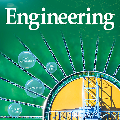Engineers widely rely on simulation platforms like COMSOL or ANSYS to model and optimise processes. However, setting up such simulations requires expertise in defining geometry, generating meshes, establishing boundary conditions, and configuring solvers. This research aims to simplify this process by enabling engineers to describe their setup in plain language, allowing a Large Language Model (LLM) to generate the necessary input files for their specific application. This novel approach allows establishing a direct link between natural language and complex engineering tasks. Building on previous work that evaluated various LLMs for generating input files across simple and complex geometries, this study demonstrates that small LLMs - specifically, Phi-3 Mini and Qwen-2.5 1.5B - can be fine-tuned to generate precise engineering geometries in GMSH format. Through Low-Rank Adaptation (LoRA), we curated a dataset of 480 instruction-output pairs encompassing simple shapes (squares, rectangles, circles, and half circles) and more complex structures (I-beams, cylindrical pipes, and bent pipes). The fine-tuned models produced high-fidelity outputs, handling routine geometry generation with minimal intervention. While challenges remain with geometries involving combinations of multiple bodies, this study demonstrates that fine-tuned small models can outperform larger models like GPT-4o in specialised tasks, offering a precise and resource-efficient alternative for engineering applications.
翻译:暂无翻译



